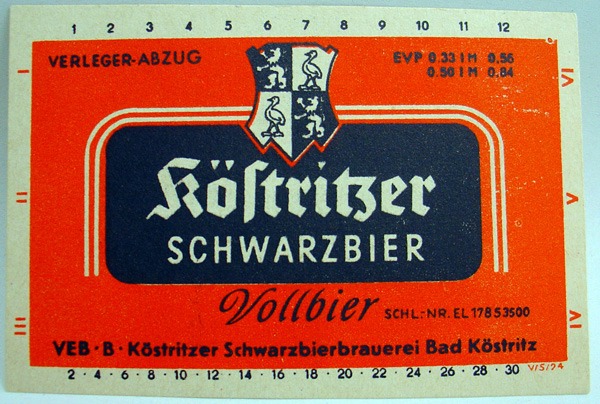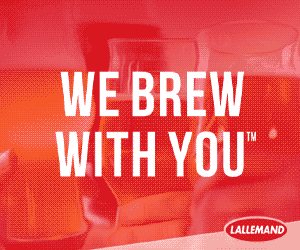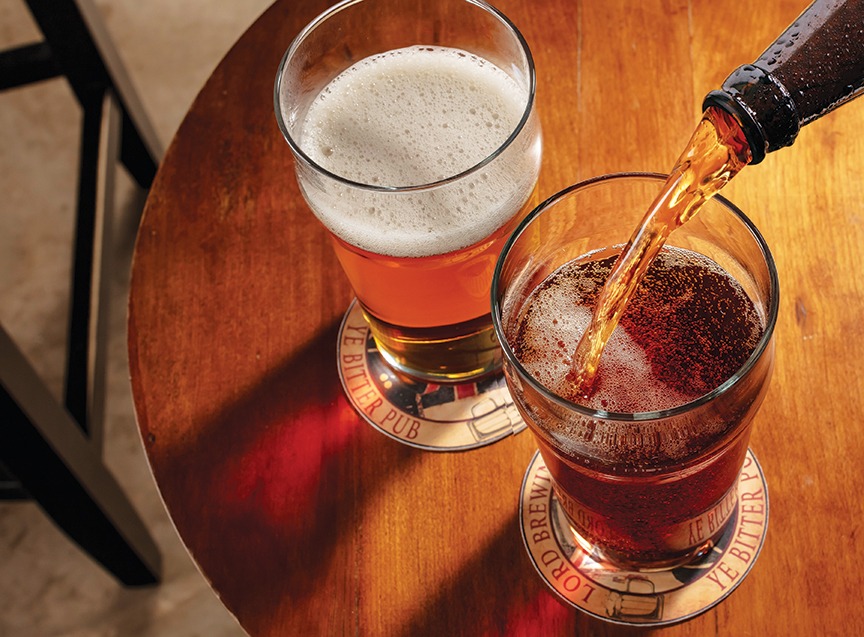Schwarzbier: Germany’s darkest beer
Germany is well-known for its wide range of pale beers, such as Pilsner, weizen, helles, Kölsch, and Gose, but it does make darker amber-to-brown beers, such as altbier, Munich dunkel, and bock. However, none of these approach black in color. There really isn’t a German tradition of making porters and stouts, unless you count the rare Baltic porter. For their darkest beer, you have to only look at its name — schwarzbier — which literally means black beer.
Despite its name, the beer itself is not actually black. It’s usually a very dark reddish brown that can look a bit black if viewed in a wide enough glass. However, it’s darker than other German beers, even if it doesn’t really approach the light-swallowing opacity of some stouts. This difference does provide some clues about the types of malt used, as well as the flavor of this beer style.
This was not a widely known style before the fall of the Iron Curtain in 1990. Michael Jackson’s World Guide to Beer gives it just a passing mention; not even a full paragraph. In his Beer Companion book, written after German reunification, the beer has a much fuller description and discussion within its own section. The fall of communism
in Eastern Europe lifted the veil from this style and allowed it to be more widely appreciated.

The Beer Judge Certification Program (BJCP) includes schwarzbier as style 8B within Category 8, European Dark Lager. The other style within this category is Munich dunkel. Amber beers and stronger beers are categorized elsewhere.
Schwarzbier History
When Jackson first mentions the beer by name, he characterizes it as a low-alcohol, sweet beer used for blending in bars, seemingly only thinking it is defined by the beer of Bad Köstritz in Thuringia (then in East Germany). He does describe black lagers in Japan, and says they were inspired by dark lagers of Kulmbach. Japanese brewers first visited Germany in the late 1800s, and took inspiration for several of their modern styles from them.
After German reunification in 1990, the large German brewery Bitburger purchased the Köstritzer brewery in Bad Köstritz in 1991 with the goal of more widely producing and exporting the beer. They reformulated the beer, changing it from the beer Jackson first described to a standard-strength beer or Vollbier.
Despite its name, the beer itself is not actually black. It’s usually a very dark reddish brown that can look a bit black if viewed in a wide enough glass.
But Köstritzer is not the only producer of this beer. Modern examples also include Kulmbacher’s Mönchshof Schwarzbier from Kulmbach in Franconia (Northern Bavaria) and Einbecker Schwarzbier from Einbeck in Lower Saxony. If you draw a triangle between Einbeck, Kulmbach, and Gera (near Bad Köstritz), you can find a region where this style has flourished. Similar to the triangle of Munich, Prague, and Vienna where lager brewing developed, you find a region where darker beers had more of a local following.
If you recall my recent article on rauchbier, you probably remember that this area is where the Frankish people settled in the Middle Ages. I’m not saying there is a strong link here, just that it seems that people that enjoyed smoky beers also would enjoy the more roasted darker beers as well. Even if the technology that produces modern dark malts hadn’t been invented yet. Some articles cite that charred barley bread used for brewing dated to 800 BCE was found near Kulmbach as evidence of Germany’s first brewing tradition. Could it be possible this is related? Seems a bit sketchy to me, except to point to perhaps a common preference for these flavors.
The one thing I don’t want to imply is that there is somehow an unbroken link for thousands of years to this style; there isn’t. Even when breweries that currently produce the beer talk about their heritage, that shouldn’t imply that all of their products were brewed continuously through this time. No, we can only point to what we know; that the beers were influenced through this regional preference and that they grew after 1990.
The way that the Japanese are characterized in Michael Jackson’s Beer Companion doesn’t lead one to believe that schwarzbier as brewed in Bad Köstritz was the influence for modern Japanese versions. Japanese brewers cited Bavaria’s dark beers as the influence, although this information serves as anecdotal evidence at best. They are popular in Japan, even if the history is murky.
I tend to look at this style as more modern in character, and reflecting the regional preferences in Germany. It can be found in many places in the world as craft beer brewers explore once obscure regional styles. The export of decent German commercial examples to the United States and elsewhere has no doubt furthered this trend. I personally think this style helped influence the development of the once popular black IPA.
Several good modern craft examples are available here in the US. Sam Adams Black Lager is on the low end of the bitterness range, but very approachable. Devil’s Backbone Schwartz Bier, pFriem Schwarzbier, and Chuckanut Schwarz Lager are all fine examples of this style. With the rise of many craft German-type lager specialists, I would seek them out for any seasonals or special releases; this style is in their wheelhouse.
Schwarzbier Sensory Profile
The first things you should know about this style is that it’s a dark German lager, so it should have all the familiar lager characteristics like a clean fermentation profile and a smooth texture. The dark color is often less than black, but darker than any other German beer. Holding the beer to a light shows that it is clear and often has ruby highlights. It is topped with a tan-colored, persistent head.
The ingredients that produce the dark color also affect the aroma and flavor. The roast character is smooth and clean, not harsh and burnt. It shouldn’t have an acrid bite. The roast often has a dark or bitter chocolate aspect, but is backed by a well-toasted bready malt backbone. In no way should this beer taste like a porter or stout, however.
The balance of bitterness needs a little explanation. Since the beer can have a variable sweetness level, expressing bitterness in IBUs is a little misleading. Sweeter and richer beers can take more IBUs while maintaining the same balance. The sensory impression is a roughly medium-bittered beer. The finish and balance can be dry to somewhat sweet, and the bitterness can be detected in the aftertaste. But this also isn’t a black IPA, so it shouldn’t have huge levels of hops, alcohol, and bitterness.
When the beer has a bit of sweetness, it often has more of a residual maltiness than a caramel-type malt flavor. Sometimes a little sweetness helps soften the finish of the beer. So focus more on the sensory aspects rather than the specific numbers.
As an average-strength beer, expect an alcohol strength slightly under 5% ABV. The body isn’t heavy, medium at most and often in the medium-low range. The smooth roasted character, light dryness, lack of full body and alcohol, and balanced bitterness combine to make this a very drinkable beer. It is not a fireside sipper.
The Kulmbacher commercial example is nicknamed, “The Black Pils” – more of a measure of the hopping level than the finished beer profile since there is clearly much more malt flavor in a schwarzbier than in a Pilsner. But it gives a hint that a firm bitterness and a noticeable late noble hop character is welcome. Fresher versions tend to have more of a late hop character, so don’t fret if imported commercial examples don’t show this aspect.
Brewing Ingredients and Methods
Both Michael Jackson and Roger Protz provide grist information for Köstritzer: 50% pale malt, 43% Munich malt, and 7% roasted malt. Looking at the range of colors they mention for the malt, I can deduce that the Munich-type malt is dark Munich and that the roasted malt is Carafa® Special I. They put IBUs at 35 (hmm, maybe those BJCP guidelines need to be adjusted up a touch . . .) and mention Hallertauer as the late hop. Yet that’s a clone recipe not guidance for a style with multiple examples.
When the beer has a bit of sweetness, it often has more of a residual maltiness than a caramel-type malt flavor.
As this is a German-style beer, I would interpret the pale malt as Pilsner malt, the base of most beers from Germany. I think Pilsner malt is needed to keep the beer from being too malty and heavy, and a range between 40 and 80% is reasonable. Pilsner, Munich, and roast malts should be the “holy trinity” of this style, but there are clearly many reasonable choices for each. Dark Munich malts have a wide range with different flavor profiles, so the brewer’s selection of maltster will influence the finished product greatly. Regular Munich malt also works but with less contribution of deep toast flavors.
For roasted malts, huskless versions will give the best results since they lack the harsh, sometimes acrid, quality of dark-roasted husked products. Since they also have less flavor impact, using a higher percentage in the grist is often needed. I think there is an interplay between the roast and the Munich malts, so if you reduce the percentage or color of the Munich malts, you may need to increase the roast malt presence. It’s a variable up to the brewer’s discretion, but I would think somewhere between 5% and 15% roasted malt would fit this style.
Since the beer has a lighter body and seeks a moderately dry finish, I would use the common German practice of step mashing to encourage attenuation. Dark Munich malt can make a heavy beer if you aren’t careful; you don’t want this beer to taste like a doppelbock after all. So respect German tradition, and do what they do. Use a mash program that has rests in the optimal temperatures for both beta amylase (144–146 °F/62–63 °C) and alpha amylase (158–162 °F/70–72 °C). A decoction mash isn’t a common practice for this style. If you use a single infusion mash, shoot for the lower end of the typical range, something around 149–151 °F (65–66 °C) to help the yeast finish with low residual sugars.
There is a bit of late hop character, so follow the typical German tradition of using your best aroma and flavor hops at the end. Hallertauer is the classic, but Tettnanger is often a good second choice. Bittering hops can be any German hop; I like Magnum for its clean character and efficient bittering, but you could also use lower alpha hops.
A clean German lager yeast is obvious, like the Weihenstephaner 34/70 strain (Wyeast 2124, White Labs WLP830, or SafLager W-34/70). Follow normal fermentation practices, pitching the yeast and fermenting around 50 °F (10 °C). Lager for two to three months near freezing to allow the yeast to condition the beer.
Homebrew Example
My recipe is fairly simple: 60% Pilsner malt, 30% dark Munich malt, and 10% roasted malt. I’m using mostly Carafa® Special I, with a little Carafa® Special III to adjust the color darker. I typically can get Weyermann Munich II, which is a lighter color than the 40 EBC malt Jackson said Köstritzer uses.
I’m targeting 30 IBUs, at the upper end of the range since I find that the Munich malts benefit from the support. Hallertauer is the classic finishing hop, and I’ll use it for aroma and flavor. First wort hopping is my choice for introducing hop flavor, and Magnum is my bittering hop; both encourage a smooth bitterness.
A classic German step mash program encourages attenuation, which is what I want when using the dark Munich malt. I’m not doing anything unusual in yeast choice or fermentation. The mash and fermentation regime are what I’d call my go-to German scheme for most styles.
This beer is brewed at the 12 °P (1.048 SG) strength, which is typical of standard-strength German beers. For me, the most important parts of this style for the brewer is to use the debittered dark malts, and to properly attenuate the beer so that it isn’t too heavy. The rest is what you’d expect from German beers: Use good technique, use fresh ingredients, and take your time with lagering.
Dark days call for a dark beer. I hope this one finds you well. Stay strong everyone.
Schwarzbier

(5 gallons/19 L, all-grain)
OG = 1.048 FG = 1.012
IBU = 30 SRM = 31 ABV = 4.7%
Ingredients
6 lbs. (2.7 kg) Pilsner malt
3 lbs. (1.4 kg) dark Munich malt
12 oz. (340 g) Weyermann Carafa® Special I malt
4 oz. (113 g) Weyermann Carafa® Special III malt
1.75 AAU Hallertauer hops (first wort hop) (0.5 oz./14 g at 3.55% alpha acids)
5.5 AAU Magnum hops (60 min.) (0.5 oz./14 g at 11.0% alpha acids)
0.5 oz. (14 g) Hallertauer hops (5 min.)
Wyeast 2124 (Bohemian Lager), White Labs WLP830 (German Lager), or SafLager W-34/70 yeast
3⁄4 cup corn sugar (for priming)
Step by Step
This recipe uses reverse osmosis (RO) water. Adjust all brewing water to a pH of 5.5 using phosphoric acid. Add 1 teaspoon of calcium chloride to
the mash.
This recipe uses a step mash. Mash in the Pilsner and dark Munich at 144 °F (62 °C) in 14 qts. (13 L) water. Hold for 60 minutes. Raise the temperature to 158 °F (70 °C) and hold for 15 minutes. Add the Carafa® malts. Begin recirculating and raise temperature to 168 °F (76 °C) and recirculate for 15 minutes.
Put the first wort hops in the boil kettle, then sparge slowly and collect 6.5 gallons (24.5 L) of wort. Boil the wort for 90 minutes, adding hops at the times indicated in the recipe.
Chill the wort to 50 °F (10 °C), pitch the yeast, and ferment until complete. Rack to secondary and lager for three months at 32 °F (0 °C). Rack the beer, prime and bottle condition, or keg and force carbonate.
Schwarzbier
(5 gallons/19 L, extract with grains)
OG = 1.048 FG = 1.012
IBU = 30 SRM = 31 ABV = 4.7%
Ingredients
4 lbs. (1.8 kg) pale liquid malt extract
2 lbs. (907 g) Munich liquid malt extract
12 oz. (340 g) Weyermann Carafa® Special I malt
4 oz. (113 g) Weyermann Carafa® Special III malt
1.75 AAU Hallertauer hops (first wort hop) (0.5 oz./14 g at 3.55% alpha acids)
5.5 AAU Magnum hops (60 min.) (0.5 oz./14 g at 11.0% alpha acids)
0.5 oz. (14 g) Hallertauer hops (5 min.)
Wyeast 2124 (Bohemian Lager), White Labs WLP830 (German Lager), or SafLager W-34/70 yeast
3⁄4 cup corn sugar (for priming)
Step by Step
Start with 6 gallons (23 L) of soft or reverse osmosis (RO) water in the brew kettle. Heat the water to 158 °F (70 °C).
Turn off the heat. Add the finely crushed Carafa® malts in a mesh bag and allow the grains to steep for 30 minutes. Remove the bag and rinse grains gently.
With the heat turned off, add the malt extracts and stir thoroughly to dissolve completely. You do not want to feel extract on the bottom of the kettle. Turn the heat back on then add the first wort hops and bring to a boil. Boil the wort for 60 minutes, adding hops at the times indicated.
Chill the wort to 50 °F (10 °C), pitch the yeast, and ferment until complete. Rack to secondary and lager for three months at 32 °F (0 °C). Rack the beer, prime and bottle condition, or keg and force carbonate.



